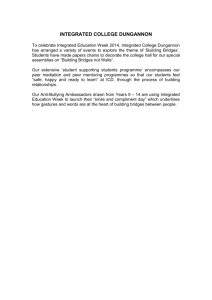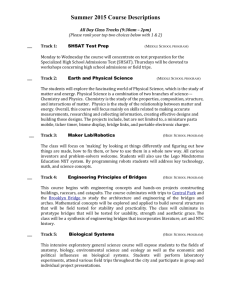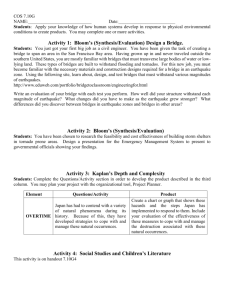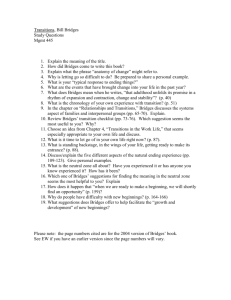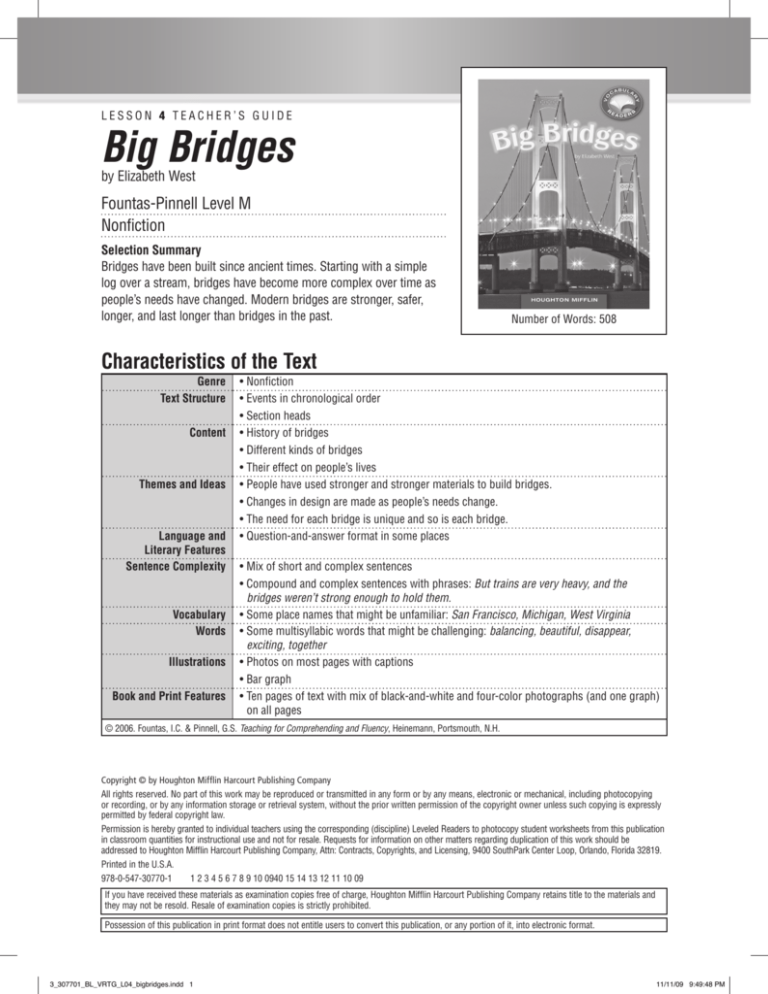
LESSON 4 TEACHER’S GUIDE
Big Bridges
by Elizabeth West
Fountas-Pinnell Level M
Nonfiction
Selection Summary
Bridges have been built since ancient times. Starting with a simple
log over a stream, bridges have become more complex over time as
people’s needs have changed. Modern bridges are stronger, safer,
longer, and last longer than bridges in the past.
Number of Words: 508
Characteristics of the Text
Genre
Text Structure
Content
Themes and Ideas
Language and
Literary Features
Sentence Complexity
Vocabulary
Words
Illustrations
Book and Print Features
• Nonfiction
• Events in chronological order
• Section heads
• History of bridges
• Different kinds of bridges
• Their effect on people’s lives
• People have used stronger and stronger materials to build bridges.
• Changes in design are made as people’s needs change.
• The need for each bridge is unique and so is each bridge.
• Question-and-answer format in some places
• Mix of short and complex sentences
• Compound and complex sentences with phrases: But trains are very heavy, and the
bridges weren’t strong enough to hold them.
• Some place names that might be unfamiliar: San Francisco, Michigan, West Virginia
• Some multisyllabic words that might be challenging: balancing, beautiful, disappear,
exciting, together
• Photos on most pages with captions
• Bar graph
• Ten pages of text with mix of black-and-white and four-color photographs (and one graph)
on all pages
© 2006. Fountas, I.C. & Pinnell, G.S. Teaching for Comprehending and Fluency, Heinemann, Portsmouth, N.H.
Copyright © by Houghton Mifflin Harcourt Publishing Company
All rights reserved. No part of this work may be reproduced or transmitted in any form or by any means, electronic or mechanical, including photocopying
or recording, or by any information storage or retrieval system, without the prior written permission of the copyright owner unless such copying is expressly
permitted by federal copyright law.
Permission is hereby granted to individual teachers using the corresponding (discipline) Leveled Readers to photocopy student worksheets from this publication
in classroom quantities for instructional use and not for resale. Requests for information on other matters regarding duplication of this work should be
addressed to Houghton Mifflin Harcourt Publishing Company, Attn: Contracts, Copyrights, and Licensing, 9400 SouthPark Center Loop, Orlando, Florida 32819.
Printed in the U.S.A.
978-0-547-30770-1
1 2 3 4 5 6 7 8 9 10 0940 15 14 13 12 11 10 09
If you have received these materials as examination copies free of charge, Houghton Mifflin Harcourt Publishing Company retains title to the materials and
they may not be resold. Resale of examination copies is strictly prohibited.
Possession of this publication in print format does not entitle users to convert this publication, or any portion of it, into electronic format.
3_307701_BL_VRTG_L04_bigbridges.indd 1
11/11/09 9:49:48 PM
Big Bridges
by Elizabeth West
Build Background
Help students to recall bridges they have seen or used. Build interest by asking such
questions as these: Were you walking across the bridge or traveling over it by car? What
was the bridge made of? What did the bridge cross over? Read the title and author’s
name and talk about the cover photo. Tell students that this book is nonfiction, so they will
notice special nonfiction features like photos, captions, and section heads.
Introduce the Text
Guide students through the text, noting important ideas and nonfiction features. Help with
unfamiliar language and vocabulary so they can read the text successfully. Here are some
suggestions:
Page 2: Explain that this book is about bridges of all kinds.
Suggested language: Turn to page 2 and read the caption. When this bridge was
built excitement filled the air because people could travel to a new place. A rope
bridge like this swings when you use it — that causes a lot of excitement, too.
Page 3: Explain that this book starts in the distant past and ends in modern times.
Point out that the ancient bridge in the picture seems to have two parts, with one
part balancing on another.
Page 6: Explain that there are bridges in every state. The graph on this page lets
you compare the number of bridges in four states. Which state has the most
bridges? Why do you think some states have more bridges than others?
Page 7: Ask students to look at the picture on page 7. What would it be like to walk
across the Golden Gate Bridge on a foggy day when parts of the bridge seem to
disappear in the fog? Would you like to try it?
Pages 7–10: Have students look at the pictures of bridges on pages 7 through 10.
These are some of the most famous bridges in the United States. Why do you think
they’re all different?
Now turn back to the beginning and read to find out why bridges were built.
Target Vocabulary
balancing — keeping steady, p. 3
cling — to stick to or hold on
tightly, p. 9
crew — group of people doing
work, p. 5
Grade 3
stretch — to extend or spread
out, p. 3
foggy — in a thick mist or low
clouds, p. 7
excitement — feeling of great
happiness, p. 2
tide — the rise and fall of the
sea, p. 5
disappears — passes from sight,
p. 7
2
Lesson 4: Big Bridges
© Houghton Mifflin Harcourt Publishing Company
3_307701_BL_VRTG_L04_bigbridges.indd 2
11/11/09 9:50:27 PM
Read
Have students read Big Bridges silently while you listen to individual students read.
Support their problem solving and fluency as needed.
Remind students to use the Infer/Predict Strategy
them figure out more about the selection.
to find clues to help
Discuss and Revisit the Text
Personal Response
Invite students to share their personal responses to the book.
Suggested language: Have you ever thought about how bridges are built? What have you
learned from this book that explains that?
Ways of Thinking
As you discuss the text, help students understand these points:
Thinking Within the Text
Thinking Beyond the Text
Thinking About the Text
• Bridges are not all alike because
they’re built in different places.
• Some bridges are beautiful as
well as useful.
• The author’s language makes it
easy to understand the subject.
• Bridges can be made of wood,
stone, iron, steel, and even rope.
• Bridge designers have to be sure
each bridge fits its place.
• Bridges need to be safe.
• Over time, bridges got more
complicated in design because
they needed to be stronger and
last longer.
• The author makes it clear that
she appreciates the craft of
building bridges.
• The book is full of photographs
of examples of many kinds of
bridges.
© 2006. Fountas, I.C. & Pinnell, G.S. Teaching for Comprehending and Fluency, Heinemann, Portsmouth, N.H.
Choices for Further Support
• Fluency Invite students to choose a passage from the text to read aloud. Suggest that
they try reading pages 7–10 as though they are conducting a tour of famous bridges.
• Comprehension Based on your observations of the students’ reading and discussion,
revisit parts of the text to clarify or extend comprehension. Remind students to go
back to the text to support their ideas.
• Phonics/Word Work Provide practice as needed with words and word parts, using
examples from the text. Point out that words ending in –er are used when the author
compares two things, as on page 3: These bridges lasted longer, and they were safer,
too. Help students identify what bridges are being compared.
Grade 3
3
Lesson 4: Big Bridges
© Houghton Mifflin Harcourt Publishing Company
3_307701_BL_VRTG_L04_bigbridges.indd 3
11/11/09 9:50:42 PM
Writing about Reading
Vocabulary Practice
Have students complete the vocabulary questions on BLM 4.1.
Responding
Have students complete the vocabulary activities on page 11. Remind them to answer the
Word Teaser on p. 12. (Answer: fling)
Reading Nonfiction
Nonfiction Features: Captions and Photos Remind students that nonfiction books like Big
Bridges have many features to help readers find and understand important information.
Photos with captions are examples. Explain that captions can be short phrases or full
sentences. Captions tell what a photo, map, or diagram is about. The photos themselves
are an important source of information. Have students look at the photo on page 7. Ask
students what information they can learn from this photo and its caption. (The bridge is
near the ocean. Orange paint protects the steel from the salty air.) Have students choose
two photos from the book and write new captions for them.
Writing Prompt: Thinking Beyond the Text
Have students write a response to the prompt on page 6.
Assessment Prompts
• In paragraph 2 on page 3, find the word that means almost the same as “staying in a
steady position.”
• On page 5, which words help the reader to know the meaning of crew?
• How does the picture on page 9 and its caption help readers to understand the
meaning of the word cling?
Grade 3
4
Lesson 4: Big Bridges
© Houghton Mifflin Harcourt Publishing Company
3_307701_BL_VRTG_L04_bigbridges.indd 4
11/11/09 9:50:58 PM
English Language Development
Reading Support Pair advanced and intermediate readers to softly read the text aloud.
Beginning speakers may also read the captions on their own.
Cultural Support Use a map of the United States to help students locate the general
area of the bridges shown on pages 7 through 10. On page 8, use the map to help
students visualize the first sentence: Michigan has two parts divided by water.
Oral Language Development
Check student comprehension, using a dialogue that best matches your students’
English proficiency level. Speaker 1 is the teacher, Speaker 2 is the student.
Beginning/Early Intermediate
Intermediate
Early Advanced/ Advanced
Speaker 1: What is this book about?
Speaker 1: Who builds bridges?
Speaker 2: bridges
Speaker 2: Crews of workers build
bridges.
Speaker 1: How do bridges
change lives?
Speaker 1: Why do bridges need to be
strong?
Speaker 2: Strong bridges are safer.
Speaker 2: They let people go to
new places.
Speaker 1: How do the workers know
what to do?
Speaker 1: Why did railroad trains
change the way bridges were
made?
Speaker 2: First someone has to plan
the bridge.
Speaker 2: The bridges had to be
strong enough to hold the heavy
trains.
3_246239RTXEAN_L01-05TV.indd Page Sec3:3 2/28/09 4:52:14 AM elhi
/Volumes/118/HS00117/work%0/indd%0/Target_Vocabulary/3_246239RTXEAN_U1L01-05TV
Lesson 4
Name
BLACKLINE MASTER 4.1
Date
Target Vocabulary
Big Bridges
Target Vocabulary
Fill in two more Examples and Non-examples for stretch.
Then create your own Four-Square Maps for two of the
remaining Target Vocabulary words. Possible responses shown.
Vocabulary
balancing
cling
crew
foggy
tide
stretch
excitement
disappears
Definition
make bigger or longer
Sentence
Stretch your arm and you can
reach the top shelf.
Read directions to students.
Target Vocabulary
Example
• a rubber band
•
elastic
•
a piece of taffy
stretch
Non-example
• a piece of lumber
3
•
a small car
•
a cracker
Grade 3, Unit 1: Good Citizens
© Houghton Mifflin Harcourt Publishing Company. All rights reserved.
Grade 3
5
Lesson 4: Big Bridges
© Houghton Mifflin Harcourt Publishing Company
3_307701_BL_VRTG_L04_bigbridges.indd 5
11/11/09 9:51:38 PM
Name
Date
Big Bridges
Thinking Beyond the Text
Think about the questions below. Then write your answer in one or two
paragraphs.
On page 2, the author says, “When a new bridge is built, excitement fills the
air.” Then she asks the question “Why?” Answer in your own words why
you think people get excited when a new bridge is built.
Grade 3
6
Lesson 4: Big Bridges
© Houghton Mifflin Harcourt Publishing Company
3_307701_BL_VRTG_L04_bigbridges.indd 6
7/29/09 5:07:46 PM
Lesson 4
Name
BLACKLINE MASTER 4.1
Date
Target Vocabulary
Big Bridges
Target Vocabulary
Fill in two more Examples and Non-examples for stretch.
Then create your own Four-Square Maps for two of the
remaining Target Vocabulary words.
Vocabulary
balancing
cling
crew
stretch
excitement
disappears
foggy
tide
Definition
make bigger or longer
Example
• a rubber band
•
•
stretch
Non-example
Sentence
Stretch your arm and you can
reach the top shelf.
• a piece of lumber
•
•
Grade 3
7
Lesson 4: Big Bridges
© Houghton Mifflin Harcourt Publishing Company
3_307701_BL_VRTG_L04_bigbridges.indd 7
7/29/09 5:07:47 PM
Student
Lesson 4
Date
BLACKLINE MASTER 4.23
Big Bridges • LEVEL M
page
Big Bridges
Running Record Form
Selection Text
2
Errors
Self-Corrections
Accuracy Rate
Total SelfCorrections
When a new bridge is built, excitement fills the air. Why?
Every bridge changes lives. Bridges let people go new places.
Bridges save travel time.
Bridges can be small or big. They can be wood, stone,
iron, or steel.
3
People need bridges. They use them to cross rivers and
valleys.
Long ago, bridges were very simple. People would stretch
a log across a stream. Then they could cross, balancing
carefully as they went.
Next, people built stone or wood bridges. These bridges
lasted longer, and they were safer, too.
4
Then people started building railroads.
Comments:
(# words read
correctly/94 × 100)
%
Read word correctly
Code
✓
cat
Repeated word,
sentence, or phrase
®
Omission
—
cat
cat
Grade 3
Behavior
Error
0
0
Substitution
Code
cut
cat
1
Self-corrects
cut sc
cat
0
Insertion
the
1
Word told
T
cat
cat
Error
1414177
Behavior
ˆ
1
8
1
Lesson 4: Big Bridges
© Houghton Mifflin Harcourt Publishing Company
3_307701_BL_VRTG_L04_bigbridges.indd 8
7/29/09 5:07:47 PM



